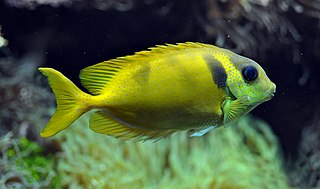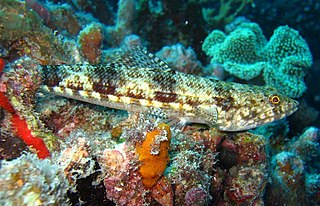
Actinopterygii, members of which are known as ray-finned fish or actinopterygians, is a class of bony fish that comprise over 50% of living vertebrate species. They are so called because of their lightly built fins made of webs of skin supported by radially extended bony spines, as opposed to the bulkier, fleshy lobed fins of the sister class Sarcopterygii. Resembling folding fans, the actinopterygian fins can change shape and wetted area easily, providing superior thrust-to-weight ratios per movement compared to sarcopterygian and chondrichthyian fins. The fin rays attach directly to the proximal or basal skeletal elements, the radials, which represent the articulation between these fins and the internal skeleton.

The Esociformes is a small order of freshwater ray-finned fish, with two families, Umbridae and Esocidae. The pikes of genus Esox give the order its name.
Lampriformes is an order of ray-finned fish. Members are collectively called lamprids or lampriforms, and unite such open-ocean and partially deep-sea Teleostei as the crestfishes, oarfish, opahs, and ribbonfishes. A synonym for this order is Allotriognathi, while an often-seen, but apparently incorrect, spelling variant is Lampridiformes. They contain seven extant families which are generally small but highly distinct, and a mere 12 lampriform genera with some 20 species altogether are recognized.

Neopterygii is a subclass of ray-finned fish (Actinopterygii). Neopterygii includes the Holostei and the Teleostei, of which the latter comprise the vast majority of extant fishes, and over half of all living vertebrate species. While living holosteans include only freshwater taxa, teleosts are diverse in both freshwater and marine environments. Many new species of teleosts are scientifically described each year.

The Osmeriformes are an order of ray-finned fish that includes the true or freshwater smelts and allies, such as the galaxiids and noodlefishes; they are also collectively called osmeriforms. They belong to the teleost superorder Protacanthopterygii, which also includes pike and salmon, among others. The order's name means "smelt-shaped", from Osmerus + the standard fish order suffix "-formes". It ultimately derives from Ancient Greek osmé + Latin forma, the former in reference to the characteristic aroma of the flesh of Osmerus.

Stomiiformes is an order of deep-sea ray-finned fishes of very diverse morphology. It includes, for example, dragonfishes, lightfishes, loosejaws, marine hatchetfishes and viperfishes. The order contains 4 families with more than 50 genera and at least 410 species. As usual for deep-sea fishes, there are few common names for species of the order, but the Stomiiformes as a whole are often called dragonfishes and allies or simply stomiiforms.

Aulopiformes is a diverse order of marine ray-finned fish consisting of some 15 extant and several prehistoric families with about 45 genera and over 230 species. The common names grinners, lizardfishes and allies, or aulopiforms are sometimes used for this group. The scientific name means "Aulopus-shaped", from Aulopus + the standard fish order suffix "-formes". It ultimately derives from Ancient Greek aulós + Latin forma, the former in reference to the elongated shape of many aulopiforms.

Marine hatchetfishes or deep-sea hatchetfishes are small deep-sea mesopelagic ray-finned fish of the stomiiform subfamily Sternoptychinae. They should not be confused with the freshwater hatchetfishes, which are not particularly closely related Teleostei in the characiform family Gasteropelecidae.

The Myctophiformes are an order of ray-finned fishes consisting of two families of deep-sea marine fish, most notably the highly abundant lanternfishes (Myctophidae). The blackchins (Neoscopelidae) contain six species in three genera, while the bulk of the family belongs to the Myctophidae, with over 30 genera and some 252 species.

The marine hatchetfishes or deep-sea hatchetfishes as well as the related bottlelights, pearlsides and constellationfishes are small deep-sea ray-finned fish of the stomiiform family Sternoptychidae. They are not closely related to and should not be confused with the freshwater hatchetfishes, which are teleosts in the characiform family Gasteropelecidae. The Sternoptychidae have 10 genera and about 70 species altogether.

Holostei is a group of ray-finned bony fish. It is divided into two major clades, the Halecomorphi, represented by the single living genus, Amia with two species, the bowfins, as well as the Ginglymodi, the sole living representatives being the gars (Lepisosteidae), represented by seven living species in two genera. The earliest members of the clade appeared during the Early Triassic, over 250 million years ago.

Protacanthopterygii is a ray-finned fish taxon ranked as a superorder of the infraclass Teleostei. They inhabit both marine and freshwater habitats. They appear to have evolved in the Cretaceous or perhaps late Jurassic, originating probably roughly 150 million years ago; fossils of them and the closely related Otocephala are known from throughout the Cretaceous.
Ateleopus is a genus of ray-finned fish in the jellynose family Ateleopodidae. It is the type genus of its family, and the order Ateleopodiformes. For some time, it was known as Podateles, because Ateleopus had been used to replace the frog genus name Atelopus, which was deemed to be a spelling error. This was mistaken, however, and the fish and frog genera reverted to their original names.

Stenopterygii are a superorder of ray-finned fish in the infraclass Teleostei. Their validity is somewhat doubtful, as the group was established to separate, out of a large group of closely related Teleostei, a mere two rather peculiarly autapomorphic orders at best. In some treatments, it is even monotypic.

The Argentiniformes is an order of marine ray-finned fish whose distinctness was recognized only fairly recently. In former times, they were included in the Osmeriformes as suborder Argentinoidei. That term refers only to the suborder of marine smelts and barreleyes in the classification used here, with the slickheads and allies being the Alepocephaloidei. These suborders were treated as superfamilies Argentinoidea and Alepocephaloidea, respectively, when the present group was still included in the Osmeriformes.

Guentherus is a genus of jellynose fishes, belonging to the Ateleopodidae family, with two recognized species:

The Neoteleostei is a large clade of bony fish mostly consisting of marine clades. Only three lineages have freshwater species: Percopsiformes (Troutperches), which lives exclusively in freshwater, Gadiformes (cods), which is largely marine except from burbot that live in freshwater and a few populations of cod in brackish water, and the Percomorpha, which in addition to several marine groups also have many freshwater forms.

Otocephala is a clade of ray-finned fishes within the infraclass Teleostei that evolved some 230 million years ago. It is named for the presence of a hearing (otophysic) link from the swimbladder to the inner ear. Other names proposed for the group include Ostarioclupeomorpha and Otomorpha.

Stomiati is a group of teleost fish belonging to the cohort (group) Euteleostei, which is a group of bony fishes within the infra-class Teleostei that evolved ~240 million years ago. Teleostei is a group of ray-finned fishes with the exception of primitive bichirs, sturgeons, paddlefishes, freshwater garfishes, and bowfins. The cohort of Euteleostei is divided into two smaller groups: the Protacanthopterygii and the Neoteleostei. Stomiati happen to be descendants of the Protacanthopterygii, and contains the order of Osmeriformes and Stomiiformes.

Tselfatiiformes is an extinct order of bony fishes from the infraclass Teleostei. The order represents the most important radiation of marine teleosts during the Cretaceous period. Fossils of tselfatiiforms are known from Europe, North America, central and northern South America, the Middle East and North Africa.

















